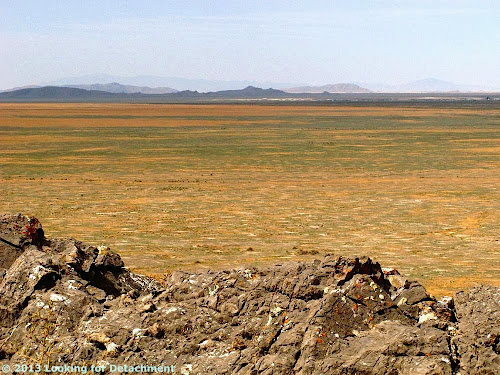 |
Lake Bonneville shorelines in the southern Lakeside Mountains, looking northeasterly from I-80 about five miles northwest of Delle, UT. |
Driving into SLC can make me somewhat apprehensive unless I'm going directly to the airport, and I had already started wondering if I was getting a migraine — possibly from normal trip concerns, possibly from driving, maybe from poor sleep the night before, possibly from some other, unknown cause.
I had looked at our route on Google Maps and had looked at the interchanges and major turns in Street View. Examining the route online is not the same as having a physical map in hand while driving (or in the navigator's hand, as the case may be) — at least not for me, or at least not unless I have some ingrained or recent familiarity with the particular roads in question. The last time I'd driven (or been driven) east through SLC without turning onto I-15 to go either north or south was in 1957 when I-80 didn't exist — and the 1957 trip definitely didn't count as recent, maybe more like Ordovician, or even late Precambrian.
I knew I was looking for the turnoff from I-80 to U.S. 40 — not that far past SLC, I thought — but I don't think I'd written down the miles to the exit, and I know I hadn't written down the exit number. And for some mysterious reason I was thinking that Park City (which I've never been to, except possibly on that long ago 1957 trip) was a lot closer to SLC than it really is.
Consequently, when the interstate turned a bit to the northeast and headed upward into the fairly tight canyon of Parleys Creek, I instantly freaked and thought it was the even narrower Echo Canyon, which I remembered from coming west out of Wyoming on I-80 on a 2006 trip. I was sure I didn't want to be heading into Wyoming on I-80, so I thought I must have missed the desired exit up somewhere near Park City (!).
I turned around at the first opportunity amidst a rash of roadwork, blocked exits, and narrowed lanes.
I knew I needed a map, so we got off at what turned out to be Exit 4 on 215. We pulled into a gas station and got some gas and a relatively small scale map of Utah. It was at this point that I was sure I had a migraine — and migraines do this funny thing to your overall thinking and analysis skills.
After examining the map while experiencing fairly moderate noise, light, and motion sensitivity that caused me to have problems looking at the map and then looking anywhere else, like at the road, I decided we were on an "outer" loop around SLC that I was previously unaware of. (This "outer loop" actually consisted of I-84 from Ogden, east and southeast to I-80 at the beginning of Echo Canyon, and south and then back west into SLC on I-80, but that part of I-80 wasn't marked, neither was 215 marked, and the insert for SLC was surprisingly small and lacking in detail.) We were actually at a gas station along the 215 partial ring road, and I probably knew that fact when I had turned on to it after turning around in Parleys Canyon.
I figured all we'd have to do was get back onto this previously unheard of "outer loop" and head east or south to our desired exit onto U.S. 40 near Park City. Wrong.
 |
| The map in question. |
Suddenly, the "outer" ring road turned due west, and I knew something was very wrong. I realized where we had to be (on the "inner loop" road, i.e. 215) just in time to navigate properly and direct us onto the exit for I-15 south. Whew!
At this point, we thought it would probably be just as easy to take the next road south over the Wasatch than to turn around and go back for I-80, Park City, and U.S. 40. As for this thought: not exactly correct.
View Our Crazy Route through SLC in a larger map
Because we went (unexpectedly, for sure) south on I-15, I was able to get a pretty decent, albeit somewhat grainy, shot of the Bingham Canyon copper mine.
 |
| View of the Bingham Canyon copper mine, looking west from I-15. |
 |
| Looking east toward American Fork Canyon. |
View Day 2: Elko, NV to Vernal, UT in a larger map
The embedded map above shows the location of the three photos in this post (and also the rest of the Day 2 photos already posted, if you move around inside the map or view it in an enlarged version).
Related Posts:
Across the West and Back Day 2: A Hike along a Limestone Ridge
Across the West and Back Day 2: Across the Salt Lake Desert
Across the West and Back Day 2: A Side Trip in West Wendover
Across the West and Back Day 2: Pequop Summit to West Wendover
Across the West and Back Day 2: Looking for an Old Roadcut
Across the West and Back: The First Day
Intro to Recent Western Loop Trip







